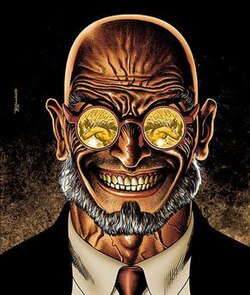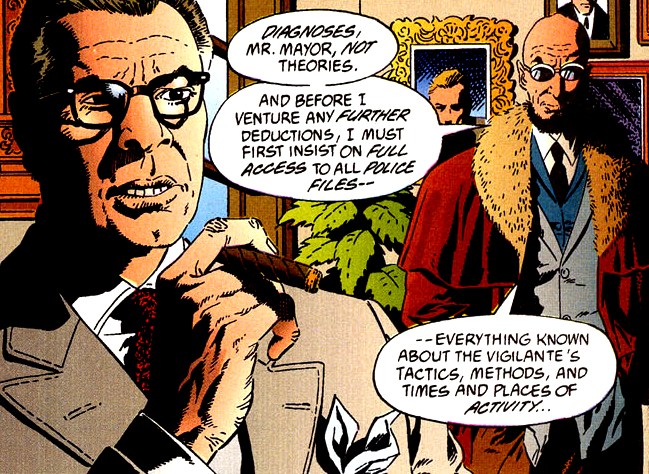Although this song has nothing to do with Graduation, this is what I'm feeling inside. (I know We Are the Champions would be a more appropriate song, but this one is more badass. Plus, it's from Highlander.)
Friday, August 17, 2012
Jacob Flores - Del Mar College Graduate of 2012
As of today, I'm a college graduate. Huzzah!
Although this song has nothing to do with Graduation, this is what I'm feeling inside. (I know We Are the Champions would be a more appropriate song, but this one is more badass. Plus, it's from Highlander.)
Although this song has nothing to do with Graduation, this is what I'm feeling inside. (I know We Are the Champions would be a more appropriate song, but this one is more badass. Plus, it's from Highlander.)
Thursday, August 2, 2012
Jacob's Comics: Batman: Prey
After seeing The Dark Knight Rises (Which was awesome by the way), I got sort of into a Batman fixation. I played Batman: Arkham City, I watched the Batman movies I owned, and re-read a lot of my Batman books such as The Dark Knight Returns, Batman: Year One, and the book I’m reviewing today, Batman: Prey (Which is the collected issues 11 to 15 of Legends of the Dark Knight) written by Doug Monench and drawn by Paul Gulacy.
I specifically bought Prey because the creators of Arkham City said it was one of the influences on the game, particularly the main villain, Professor Hugo Strange. Batman: Prey features Batman early in his career, not long after the events of Batman: Year One. Thanks to numerous references to Year One (even Batman’s cursive thought captions and Gordon’s print ones are reused), one could almost say this is a sequel.
The Mayor of Gotham is tired of Batman’s vigilantism and sets up James Gordon, who by this time is only a captain, as the leader of the Vigilante Task Force dedicated to bring in Batman. Also in this Task Force is Professor Hugo Strange, a psychologist who intends to find out Batman’s identity and what makes him tick.
Unbeknownst to the mayor and the police, Strange is ridiculously obsessed with Batman, envious of his abilities and wishing he could be him, even owning a makeshift Batman costume.
To help him flush Batman out, Strange manipulates one of Gordon’s officers on the Task Force, Max Cort (Who‘s already tired of Batman doing the police‘s job for them), into becoming a vigilante himself called the Night Scourge. While Batman doesn’t kill the bad guys he encounters, Night Scourge has no problem cutting up the thieves and gangsters of Gotham with swords.
To make matters worse, Strange orders Night Scourge to kidnap the mayor’s daughter, framing Batman in the process. Throughout all of this, Strange’s television appearances are slowly getting to Batman, making him doubt his well-being and state of mind.
Also, a small subplot throughout the story features Catwoman who, having just started her burglary career, is getting increasingly frustrated of the accusations by the media of being Batman’s partner.
This story, along with Grant Morrison’s Arkham Asylum: Serious House on Serious Earth, explores the concept that someone who dresses up like a bat and goes out at night to fight crime may not be the most mentally well person. Strange uses this idea to try and figure out what type of past trauma caused Batman to be…well, the Batman.
I found Strange to be a particularly fascinating villain, not only because of his Batman obsession, but he’s a villain that’s trusted by the public to help stop the vigilante “menace” in Gotham City. Batman does anything to him, the public will be out for Batman’s head and only solidify his dangerous vigilante status. Strange has been used before as a villain albeit as more of a mad scientist. As a result of DC comic's epic Crisis on Infinite Earths storyline, all of the convoluted backstories where wiped out, so the company could start anew. Professor Strange, being one of the changes, went from mad scientist to psychologist.
In all, Batman: Prey was an very suspenseful and intriguing read, sure to please any Batman fan and anyone who wants to see Batman in his early years.
As an addendum, not to spoil too much, Strange comes extremely close to figuring out Batman’s identity in this story. But from what I gather after this story, he eventually does put two and two together in following stories. This was put to chilling effect in Batman: Arkham City where you can visit the alleyway where Batman’s parents where killed only to find Strange has left a chalk outline of the bodies and an audio tape, taunting him. Professor Strange was voiced by veteran voice actor Corey Burton.
I specifically bought Prey because the creators of Arkham City said it was one of the influences on the game, particularly the main villain, Professor Hugo Strange. Batman: Prey features Batman early in his career, not long after the events of Batman: Year One. Thanks to numerous references to Year One (even Batman’s cursive thought captions and Gordon’s print ones are reused), one could almost say this is a sequel.
The Mayor of Gotham is tired of Batman’s vigilantism and sets up James Gordon, who by this time is only a captain, as the leader of the Vigilante Task Force dedicated to bring in Batman. Also in this Task Force is Professor Hugo Strange, a psychologist who intends to find out Batman’s identity and what makes him tick.
Unbeknownst to the mayor and the police, Strange is ridiculously obsessed with Batman, envious of his abilities and wishing he could be him, even owning a makeshift Batman costume.
 |
| Your tax dollars at work, people. |
To help him flush Batman out, Strange manipulates one of Gordon’s officers on the Task Force, Max Cort (Who‘s already tired of Batman doing the police‘s job for them), into becoming a vigilante himself called the Night Scourge. While Batman doesn’t kill the bad guys he encounters, Night Scourge has no problem cutting up the thieves and gangsters of Gotham with swords.
 |
| As much as I hate to admit it, Night Scourge just screams "early 90's". |
Also, a small subplot throughout the story features Catwoman who, having just started her burglary career, is getting increasingly frustrated of the accusations by the media of being Batman’s partner.
This story, along with Grant Morrison’s Arkham Asylum: Serious House on Serious Earth, explores the concept that someone who dresses up like a bat and goes out at night to fight crime may not be the most mentally well person. Strange uses this idea to try and figure out what type of past trauma caused Batman to be…well, the Batman.
I found Strange to be a particularly fascinating villain, not only because of his Batman obsession, but he’s a villain that’s trusted by the public to help stop the vigilante “menace” in Gotham City. Batman does anything to him, the public will be out for Batman’s head and only solidify his dangerous vigilante status. Strange has been used before as a villain albeit as more of a mad scientist. As a result of DC comic's epic Crisis on Infinite Earths storyline, all of the convoluted backstories where wiped out, so the company could start anew. Professor Strange, being one of the changes, went from mad scientist to psychologist.
 |
| That's a face you can trust, right? |
As an addendum, not to spoil too much, Strange comes extremely close to figuring out Batman’s identity in this story. But from what I gather after this story, he eventually does put two and two together in following stories. This was put to chilling effect in Batman: Arkham City where you can visit the alleyway where Batman’s parents where killed only to find Strange has left a chalk outline of the bodies and an audio tape, taunting him. Professor Strange was voiced by veteran voice actor Corey Burton.
Subscribe to:
Comments (Atom)

